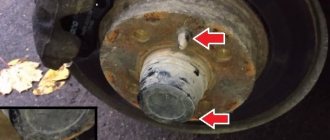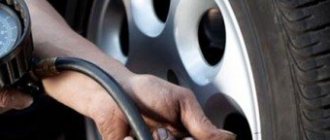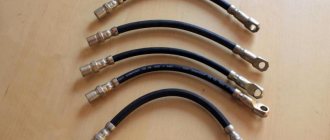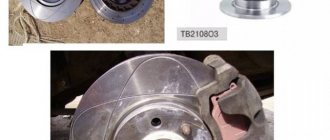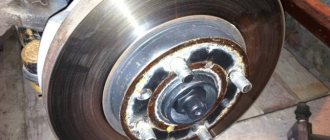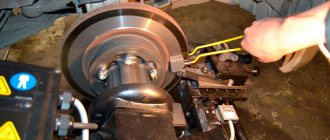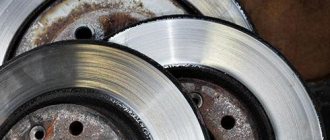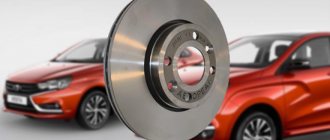When to change brake discs
There is no specific operating time or set mileage of the car in case of replacing the TD. And yet, many car enthusiasts face this problem.
Signs of a faulty brake system are determined quite simply:
- squeaking around the wheels when you press the brakes;
- increased brake pedal travel, so-called sagging;
- a significant decrease in the fluid level in the main brake reservoir;
- When you press the brakes, the car pulls to the side or a vibration is felt.
What caused the appearance of such signs of malfunction in the vehicle is determined by a visual inspection of the condition of the mechanisms, in particular, the degree of wear of the brake discs and pads on all wheels is determined. Based on its results, a decision is made whether the brake pads need to be changed or whether the brake discs need to be replaced.
Wheels from scratch to V-break bikes
There are not many bicycles on which you can install vibration breaks and discs; the lack of versatility is a significant drawback of rotors. Therefore, switching from rim brakes to disc brakes is not so easy, because you will need to make changes to the design of the bike.
The modification of the brake system concerns the wheel. Its bushing must be “sharpened” for the disk, that is, have special seats for it. This is usually not provided on bikes with v-brake. Here you can go in two ways: put a new wheel with a bushing under the rotor or change only the bushing. The first way is easier:
- you can immediately begin installing the disk;
- there is no risk of assembling the wheel incorrectly (do-it-yourself reassembly);
- You won’t have to spend extra money on installing a new bushing in the workshop.
At the same time, a new wheel for a disc will cost money; there will not be much difference in price. But in terms of time, buying a immediately assembled wheel is a more profitable option.
A quality disc brake kit doesn't come cheap. For the first test, you don’t need to start with two disks - just change the system on the front part. It's possible that the wheels won't live up to your expectations or in practice won't be any better than a V-brake, so it's best to experiment with one wheel.
The procedure for installing a disc brake looks like this:
- Place the caliper on the frame using adapters.
- Screw the brake lever onto the steering wheel.
- Connect the drive lever to the caliper via a drive (cable or hydraulic line) and align its position.
- Attach the rotor to the wheel hub.
- Install the wheel.
An important point is the adjustment of disc brakes. An incorrectly or not adjusted brake will work ineffectively and interfere with movement.
Since discs are divided into mechanical and hydraulic, it is worth taking a closer look at the installation of both.
Preparing to replace the AP
Having determined that the TD is faulty, you need to prepare to change them yourself. To do this, you first need to buy a new spare part from a car store.
When choosing brake discs for his car, the car owner must take into account his driving style. Does he like to accelerate sharply and actively maneuver? How often does he use the brakes? He drives a lot around the city or mostly intercity trips on the highway.
The spare part from which manufacturer you need to buy depends on these factors. Discs can be standard or sports.
- Standard TD - made of cast iron, the casting is processed on a milling machine. They are ventilated and non-ventilated. Without ventilation, it is a single disc that is pressed on both sides by brake pads. A disk with ventilation is easy to distinguish - it is two disks connected by bulkheads. Ventilation occurs during movement due to air entering between these pancakes. Some of the respected manufacturers of these products are Bosh, Zimmerman, ATE.
- Sports TD - made of durable and ultra-strong gray cast iron, as well as austenitic stainless steel. These are considered to be more durable products that can last much longer and with more aggressive driving. Such discs are produced by EBC, DBA, Brembo.
The driver must remember that when the front brake discs are replaced, they must be changed in pairs, even if one of them is suitable for further use in all respects. The same rule applies to rear brakes.
This rule is explained by the fact that unequal weight of the same type of spare part on the wheels of the same axle will lead to loss of directional stability.
Thus, for repairs, two or four TDs are purchased, but in no case one or three.
In the garage or at a special technical site, the tools and materials needed for repairs are prepared in advance.
- Jack and wheel wrench.
- Keys to "13" and "17".
- Ratchet wrench.
- Large flathead screwdriver.
- Thin flathead screwdriver.
- Clamp.
- A piece of wire to fix the stupor.
- Hammer.
- WD fluid to unscrew stuck fasteners.
- Brake fluid, in case of bleeding the brakes.
- Rags.
Place the machine in a hole or on a prepared level area. Decide in advance whether the rear brake discs need to be replaced or only the front ones need to be replaced. This determines how to jack up the car. Raise the entire side or just the front wheels.
After raising the car with a jack, remove the wheel using a balloon. Clean the released brake mechanism and the surface of the hub from dirt and oil using a brush and rag.
How to install power disc brakes
Mechanical brakes instead of rim brakes are the best solution, especially for a budget bike. It’s easy to install, and spare parts will be cheaper compared to hydraulics. The transition is also justified by the curvature of the rim surface - vibration breaks do not brake well under such conditions and often become upset. Of course, a curved surface, even in the absence of figure eights, is not very good. But if the hub allows you to mount a disc, and the wheel itself has proven itself well over several years, why not try it?
Replacing an old worn-out brake will also not cause difficulties: everything is in front of your eyes, the main thing is to buy the same thing and install it in the right sequence.
To work you will need:
- lever, caliper with pads and adapter (bolts should be included in the kit);
- rotor, bolts and washers for securing to the bushing;
- cable;
- wire cutters for shortening the cable;
- hexagon (for caliper and brake lever);
- clamps (fixing the cable on the frame for the rear brake).
Hobbyists use bolts of suitable diameter and length to mount the disc onto the bushing.
In principle, this can be done, the main condition is that the screws must fit completely into the mounting holes, otherwise the disk will not hold.
Installing mechanical brakes: 1. Turn the bike over and remove the wheel.
2. Remove the old caliper and disc, release the cable from the drive lever and remove it (for replacement).
3. Release the V-brake and remove it from the bike.
4. Screw the rotor to the wheel hub with 6 mounting screws. The washers under the bolts will help to tighten all the way and distribute the forces evenly.
5. Install (or adjust) the brake handle. Using a hexagon, secure the position of the lever and drive cable.
6. Place the caliper on the frame using the adapter. At the first stage, there is no need to secure it all the way, since you will have to adjust its position under the surface of the rotor.
7. Pull the cable onto the caliper.
8. Place the wheel on the eccentric or nuts.
The last stage of proper installation is adjusting the caliper relative to the disc surface. It is necessary to set the position of the pads - it will be several times smaller than that of rim pads, and on average - 0.3 - 0.4 mm.
The size of the gap between the surface and the pads is affected by the tension of the cable. Its adjustment is carried out with a hexagon on the side of the clamping mechanism. We remove the excess length of the cable with wire cutters. When the pads are in the correct position and the brakes are applied at half lever compression, fully secure the caliper to the bolts.
So, after installation and careful configuration, we roll out the bike and check the operation of the system in real conditions.
kak.feedjc.org
I decided to give the discs for sharpening for the following reasons.
1.
I bought brakes from an Audi RS3 second-hand (as I chose/installed here, so the condition of the brake discs was not ideal (the disc itself could easily be overheated, i.e. 2 uneven planes of the disc, as well as an uneven 3rd plane - contact with the hub) and When braking at speeds over 180 km/h, a slight beating was felt on the brake pedal, therefore, when braking at higher speeds, it increased. This did not bother me much, but I still wanted it at such speeds so that nothing would interfere.
2.
I rolled the pads in 0 and they already began to spoil the disc, which was accompanied by a loud squealing sound. The pad wear sensor triggered, after reading, talking, I realized that other people normally drive 500-1000 km on them, so I was calm. But after 150 km after the message appeared, That's when the hard sound of the rolled pads rubbing against the disc appeared. I bought replacement pads ATE 13.0460-4833.2 for 3,400 rubles (the original VAG 8J0 698 151 K costs 33,000 Original + replacements, horror, of course), went to the service center - everything was confirmed: pads with On one side they were completely worn out, on the other side there was still something left, and the discs from the 0x pads had deteriorated.
Here the beating appeared at any speed, it’s even a little funny on the one hand: you’re driving at 30 km/h and you start to slow down in front of a red traffic light in the distance and you feel a gradual beating on the brake pedal until the car stops. Well, at speeds over 150 km/h it was no longer comme il faut, the beating was very strong.
Of course, you can buy new discs from TT RS, but they cost 13,000 rubles for one (8J0 615 301 F) + I also need to buy spacers for the wheels, since otherwise the caliper will rest against the disc. Next time I will buy these wheels and spacers, but for now I decided to bother and save money. I read Drive2, did a little research on the Internet, and found a couple of companies. Some make a groove without removing the discs from the hub.
Grooving without removing brake discs
Others do the grooving of discs separately, but you need to bring the discs yourself. Well, there are companies that do everything themselves on their premises, removing the wheels, their rims, spacers, etc., and installing them back, of course. This is what I found.
Grooving with removal of brake discs
Having removed the wheels, we initially measured the runout before the groove, it turned out to be 0.4 mm on one side, which is really a lot, since the norm is up to 0.08 mm, i.e. I had a 5 times excess. All 3 planes of the brake discs were uneven, very uneven, strong grooves, signs of overheating. Also, my spacers between the hub and the brake disc were removed from the brake discs; they were slightly bent from the load, and were also not in tight contact with the plane of contact of the disc to the hub.
Disc BEFORE groove
Disc AFTER grooving
Well, the difference is obvious, all three surfaces have become smooth. We ground off 0.15 mm on each side of the disk. We also ground the spacers, polished the pads (the pads are fresh - they were one week old and had 150 km on them), and the surface of the hub.
All this is done in order to achieve perfectly smooth surfaces. Since any gap or unevenness in the hub area is transmitted by beating to the disk with greater force. Measuring the runout after grooving showed a runout on the side of 0.04-0.05mm, which is within normal limits. The work took 2 hours. Now I drive inactively, I roll everything in, without sudden braking or overheating. When braking from a speed of 180 km/h I did not notice any beating in the brake pedal.
So I recommend regrooving if your discs are quite expensive and there are no substitutes!
Purpose of the wheel stud
The issue of attaching a wheel to an axle had to be resolved by our distant ancestors, who built various carts and carts. With the invention of cars, this issue did not lose its urgency, since increased speeds and loads required more reliable fixation of the wheel on the axle or on the hub. Until the 20s - 30s of the last century, wheel fastening was done in various ways (bolts, rivets, etc.), but later fastening to the hub using studs and nuts became standard.
Why exactly did studs take their place in the wheels of modern cars? This is primarily due to a reduction in the number of parts while simultaneously increasing the reliability of fasteners. The fact is that the use of studs makes it possible to eliminate the need for separate fastening of the wheel disc and the brake drum/suit - both of these parts are attached to the hub with the same studs. And for a number of reasons, pressing the wheel to the hub with nuts is more reliable than with bolts.
Thus, wheel studs perform several functions:
- Attaching the brake drum/disc to the hub;
- Fastening the wheel to the hub;
- Centering the parts relative to the hub;
- Increased reliability of wheel and brake drum/disc fastening.
Wheel studs play an important role in the reliable operation and safety of the car, but at the same time they have an extremely simple design and operating features.
Additional questions and answers
What is the service life of brake pads and brake discs?
There are many factors that influence the average lifespan of your brake components. These include pad type, rotor type, your personal driving style and maintenance. According to most brake pad companies and qualified mechanics, brake pads can last between 30,000 and 120,000 kilometers. At the same time, the front ones wear out about 3 times faster than the rear ones. On average, it is recommended to change pads on domestic cars approximately every 10,000 km, and on foreign cars - every 20,000 km. Actual service life can vary greatly, the main thing is to prosodicly check them and their thickness.
Left - new pads, right - old
The service life of brake discs is quite long - 3-4 times longer than that of pads. But again, it all depends on many other factors, such as how you maintain your braking system and how you drive your car. On average, this is more than 100,000 km. Here you also need to rely on the thickness of the rotors when taking measurements.
How much do new brake discs cost?
The average cost of new brake discs varies from 3,000 to 5,000 rubles each. Some rotors with the best characteristics can cost from 7000+ rubles each. Additionally, prices vary greatly depending on the type, brand, and quality.
New brake discs
When it comes to replacing brake rotors, some people often wonder whether they should buy new or remanufactured parts. Each of these types has its own advantages and disadvantages. For example, aftermarket parts tend to be cheaper and available in a wide range of options, while new brake rotors are easier to select and offer greater quality assurance.
Can I drive with worn rims?
Brake rotors play an important role in allowing your car to stop while it is in motion. If the rotors are not working properly, you may not be able to stop the machine properly in an emergency. This can lead to many dangers if you need to stop to avoid pedestrians, bicycles, car accidents or other traffic situations. So when you find that your brakes aren't performing as well as they should, you need to take your car to a mechanic as soon as possible to have the thickness of your rotors checked.
Operation of the pads
Those factors that influence the wear of brake discs also interact with the pads. On the front wheels they wear out faster than on the rear wheels, since the main load falls on the front of the car. In case of replacement, the pads are changed along the axes - on all front or rear wheels.
Uneven wear of the brake pads may be due to a malfunction of the working cylinders, and, accordingly, the different pressure they supply to the brakes. A difference in the thickness of the pad lining of 1.5-2 mm indicates a problem in the system.
We list the recognition methods that require replacing brake pads:
- Upon visual inspection. A friction lining thickness of 2-3 mm is considered insufficient.
- Mechanical method. The pads may have special metal plates, which, when the linings wear down to 2-2.5 mm, will come into contact with the disc and produce an unpleasant grinding noise.
- Electronic method. A wear sensor is installed on the brake pad, which, when it comes into contact with the disc, closes the circuit, and the indicator on the dashboard immediately lights up.
What is the essence of the groove?
During operation, barely noticeable grooves may appear on the surface of the brake disc. Most often they form at the edges of contact between the disc and the brake pad.
Grooving the brake discs makes it possible to remove existing effects and polish the surface.
And here, as we already mentioned above, you need to clearly know the minimum permissible thickness of the disk (this will prevent you from removing excess).
How was the problem solved 10-20 years ago? The car enthusiast removed the faulty rims and stood at the lathe (or turned to a professional technician).
On average, the full range of work took about 5-6 hours. In this case, it was not easy to remove the excess layer, but also to correctly balance the disk in relation to the hub. One mistake could lead to loss of control.
Today everything is done more professionally.
There are two options for doing the job.
Groove without removal.
Here, in most cases, a special machine is used. Its feature is the programming of all necessary parameters.
In this case, the grooving of the brake discs is carried out automatically. Eliminating the need to remove the disc from the machine speeds up repair time.
Special machines are made in a heavy body, which eliminates any vibrations during work and guarantees high precision stripping.
Modular devices located on mobile carts are also popular. Their feature is the presence of several speed modes and the ability to accurately select the necessary cutters.
Before processing, the machine is raised 1-1.5 meters. After this, the wheel and caliper are removed.
Once everything is ready, a special module is installed.
During grooving, the hub is rotated by a special drive module, and the cutters themselves move along the outer part of the disk. Ten minutes and the job is done.
The latest models of machines have special motors that are capable of feeding in two directions. There is also a function that allows you to slow down or, conversely, speed up the disk rotation process.
The PRO-CUT installation is very popular.
Its capabilities allow you to quickly return to the previous rotation geometry and keep the work under constant control.
Grooving brake discs with removal.
Performed on a special machine. In this case, the surface is processed on both sides at once, which improves the quality of work and simplifies the further process of wheel balancing.
The sanding itself is very simple. The disc is removed from the car, installed on a special frame and clamped with a chuck.
After processing the disc on both sides, its surface is sanded to perfection.
Next, the disc is checked for runout, which should not exceed 0.1 mm.
05–3
Some resellers only grind chamfers off disks. There will be no fresh traces left after a couple of days of operation or idle time of the machine. The buyer will no longer be able to evaluate the performance by touch and determine how much the car actually ran. Some resellers only grind chamfers off disks. There will be no fresh traces left after a couple of days of operation or idle time of the machine. The buyer will no longer be able to evaluate the performance by touch and determine how much the car actually ran.
Hydraulic System Installation
Hydraulics has a number of advantages over mechanics:
- absence of “intermediate force losses” - the fluid pressure is the same both in the hydraulic line and at its outlet to the cylinders;
- better braking and modulation;
- are adjusted once and for a long time (with the exception of single-piston models, for example, Hayes Sole), thanks to which they do not get lost or whistle after an accidental fall of the bicycle.
At the same time, hydraulics are more expensive, cannot be repaired in field conditions, and are “afraid” of air.
So, before installation, you need to fill the system with liquid. Shimano uses a special mineral-based oil; for other disc brake models, it uses DOT fluid.
To remove air, pumping of the hydraulic line is used - pushing liquid under pressure. To prevent the system from becoming airborne during operation, it is necessary to tightly fasten the hydraulic line to the working and power cylinder - this is where bubbles are most likely to appear, with the exception of a rupture of the hose itself.
To work on installing a hydraulic disc brake on a bicycle, you will need the same tools as with mechanics, and the sequence of work is similar:
- Remove the wheel from the bicycle and install the brake disc on its hub.
- Install the brake lever and connect the hydraulic line to it.
- Place the caliper with adapter on the frame. As with mechanics, there is no need to lock it all the way.
- Screw on the wheel and rotor.
- Straighten the hydraulic line using clamps. On a bicycle where hydraulics are provided by the manufacturer, there are special guide cells.
- Connect the hydraulic line and check its operation by smoothly pressing the handle - the pads should compress the disc equally.
- Pressing the pads against the disc puts the caliper in the working position, after which tighten the mounting bolts until they stop.
- If the pads rub against the disc or fit unevenly, press the handle 10 - 20 times, holding the caliper manually.
Incorrect position of the caliper on the hydraulics is the main reason why the brake does not work well. If necessary, you need to unscrew the part and repeat its installation.
